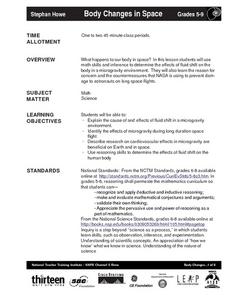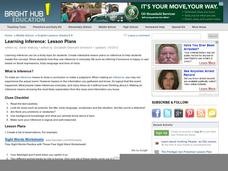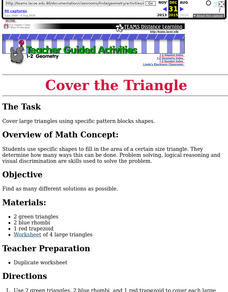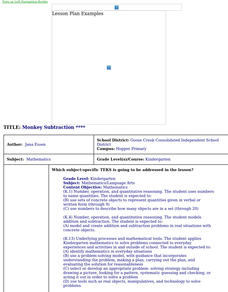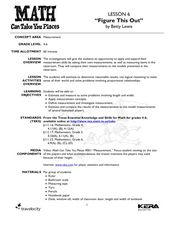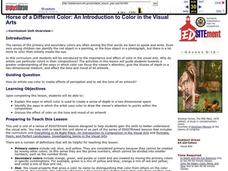Curated OER
Body Changes in Space
Learners explain the cause of and effects of fluid shift in a microgravity
environment. Students identify the effects of microgravity during long duration space flight. Learners describe research on cardiovascular effects in microgravity...
Curated OER
Noughts
Students try to figure out the strategies to the game Noughts. Students logic must play a part in the process of the game. Students apply the symmetries of regular polygons. Students devise ways to critically follow a chain of reasoning.
Curated OER
Mathematical Proofs
Students explore the nature of mathematical proofs and mathematical inquiry. They complete the activity "Using the Pythagorean Theorem". They read selected articles and participate in class discussions.
Curated OER
That's Not Fair
Fourth graders in pairs, go to the front of the class, where one student is given five pieces of candy in one hand and four in the other. The other student is given four candies in one hand and none in the other. They discuss if they...
Curated OER
Time Problems
Students make sensible estimates and check for reasonable results. They also solve problems with positive and negative integers using practical activities or models as needed.
Curated OER
Sea Ice Research
Learners study sea ice and its importance in climate and climate change. They discuss sea ice as a presence of a food source for marine animals in the arctic and complete a lab activity. After completing the lab, they watch a video...
Curated OER
Can Stack
Learners are able to find the rule for summing consecutive numbers;
identify the pattern of triangular numbers. They then solve the given problem using logic and mathematical reasoning.
Curated OER
Ecology: Symbiosis
Eighth graders identify various types of symbiotic relationships. In this ecology lesson, 8th graders predict whether certain organisms can form symbiosis with other organisms. They discuss and defend their reasoning.
Curated OER
Lifestyles of the Tribe, or Tomorrowland?
Eighth graders identify with and analyze through writing various Indian cultural values and how they fit in the modern world. Students organize data utilizing Educational software programs and present their opinions and inferences in a...
Curated OER
Learning Inference
Making inferences can be a tricky proposition for middle schoolers. In the lesson presented here, pupils practice the skill of drawing a conclusion and making a judgment - which are what making an inference is all about! There are five...
Curated OER
An Introduction to the Night Sky and Movement Astronomy
Basically, this is an interactive exploration of educational astronomy software and an app. Young astronomers discover how the apparent motion of the sky relates to Earth's movements and the position of the observer. It is out of this...
NASA
Connecting Models and Critical Questions
Scholars use data to analyze and determine which sets of information need to be counted. They create a model to explain differences among chemical elements using graphs to prove concept mastery.
Curated OER
Respecting Nonreligious People
Help students understand what an atheist is and why it is important or respect their beliefs. Using this non believers lesson, students will learn about people who hold different beliefs are discriminated against by others. They will...
Curated OER
Ancient Greece
Sixth graders examine the research that archaeologists have done on a Late Bronze Age shipwreck in order to work out the extent of trade in the Eastern Mediterranean during this period, with emphasis on the involvement of the Mycenaeans...
Curated OER
Persuasive Elements
Investigate letters to the editor and their persuasive qualities. Break your class into reading groups and give each one a different article. As they read, they complete a graphic organizer to record their thoughts and opinions. There is...
Curated OER
Belief Systems Along the Silk Roads
Learners examine cultural diffusion. In this Silk Road lesson, students research primary sources to compare and contrast the religious beliefs encountered and shared by those who traded along the Silk Road route.
Alabama Learning Exchange
Are Your Numbers Round?
Elementary schoolers investigate how to round numbers to the nearest tenth. In this number sense lesson, learners view a video clip on the Internet to practice rounding numbers. They use place value charts to help aid in the rounding...
Curated OER
Cover the Triangle
Learners explore geometric shapes using pattern blocks. They use specific shapes to fill in triangles, color-in their solutions, and discuss the results with a partner.
Curated OER
Monkey Subtraction
Students listen to the book Five Little Monkeys Sitting In a Tree, identify written numbers 0-9 and the symbol for subtraction; students subtract two single digit numbers using manipulatives, and recite the corresponding number sentence.
Curated OER
Figure This Out
Students measure different parts of the human body. In this measurement lesson, students work in pairs to take measurements of human measurements which include: arm span, height, foot length, and wrist to longest finger. They also...
Curated OER
Wilderness Survival: A Field Practicum
Students are provided with hands-on-field testing of authentic applications from principles pertaining to: Psychology A. Develop a positive, can-do attitude with a high degree of self-reliance that is transferable to human interactions...
Curated OER
Table Settings
Students make organized lists and find patterns to help them solve problems. They draw table formations and label how many people can sit there. They make predictions about how the tables be set up and what happen to the seating.
Curated OER
Water Treatment Plant Tour
Students define vocabulary related to geometry and calculate the volume. In this geometry lesson, students calculate flow rates, and volume as it relates to a water plant facility. They calculate the volume of three dimensional shapes...
Curated OER
Horse of a Different Color: An Introduction to Color in the Visual Arts
Students examine how artists use color to create a sense of depth in a two-dimensional space. They view and analyze prints, complete worksheets, and write a paragraph on how color is used to draw the viewer's eye to a central figure.


